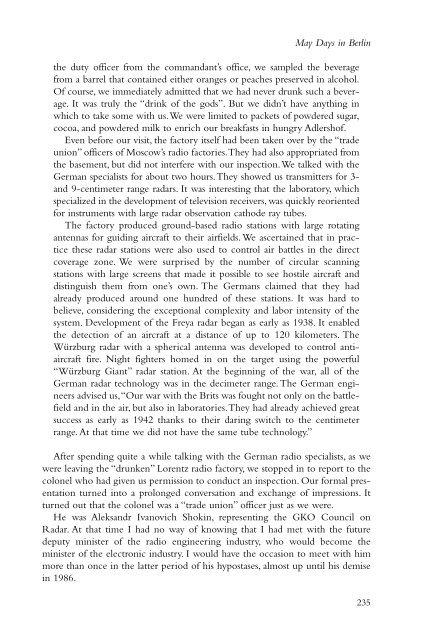to open next chapter. - NASA's History Office
to open next chapter. - NASA's History Office
to open next chapter. - NASA's History Office
You also want an ePaper? Increase the reach of your titles
YUMPU automatically turns print PDFs into web optimized ePapers that Google loves.
May Days in Berlin<br />
the duty officer from the commandant’s office, we sampled the beverage<br />
from a barrel that contained either oranges or peaches preserved in alcohol.<br />
Of course, we immediately admitted that we had never drunk such a beverage.<br />
It was truly the “drink of the gods”. But we didn’t have anything in<br />
which <strong>to</strong> take some with us.We were limited <strong>to</strong> packets of powdered sugar,<br />
cocoa, and powdered milk <strong>to</strong> enrich our breakfasts in hungry Adlershof.<br />
Even before our visit, the fac<strong>to</strong>ry itself had been taken over by the “trade<br />
union” officers of Moscow’s radio fac<strong>to</strong>ries.They had also appropriated from<br />
the basement, but did not interfere with our inspection.We talked with the<br />
German specialists for about two hours.They showed us transmitters for 3and<br />
9-centimeter range radars. It was interesting that the labora<strong>to</strong>ry, which<br />
specialized in the development of television receivers, was quickly reoriented<br />
for instruments with large radar observation cathode ray tubes.<br />
The fac<strong>to</strong>ry produced ground-based radio stations with large rotating<br />
antennas for guiding aircraft <strong>to</strong> their airfields. We ascertained that in practice<br />
these radar stations were also used <strong>to</strong> control air battles in the direct<br />
coverage zone. We were surprised by the number of circular scanning<br />
stations with large screens that made it possible <strong>to</strong> see hostile aircraft and<br />
distinguish them from one’s own. The Germans claimed that they had<br />
already produced around one hundred of these stations. It was hard <strong>to</strong><br />
believe, considering the exceptional complexity and labor intensity of the<br />
system. Development of the Freya radar began as early as 1938. It enabled<br />
the detection of an aircraft at a distance of up <strong>to</strong> 120 kilometers. The<br />
Würzburg radar with a spherical antenna was developed <strong>to</strong> control antiaircraft<br />
fire. Night fighters homed in on the target using the powerful<br />
“Würzburg Giant” radar station. At the beginning of the war, all of the<br />
German radar technology was in the decimeter range. The German engineers<br />
advised us,“Our war with the Brits was fought not only on the battlefield<br />
and in the air, but also in labora<strong>to</strong>ries.They had already achieved great<br />
success as early as 1942 thanks <strong>to</strong> their daring switch <strong>to</strong> the centimeter<br />
range. At that time we did not have the same tube technology.”<br />
After spending quite a while talking with the German radio specialists, as we<br />
were leaving the “drunken” Lorentz radio fac<strong>to</strong>ry, we s<strong>to</strong>pped in <strong>to</strong> report <strong>to</strong> the<br />
colonel who had given us permission <strong>to</strong> conduct an inspection. Our formal presentation<br />
turned in<strong>to</strong> a prolonged conversation and exchange of impressions. It<br />
turned out that the colonel was a “trade union” officer just as we were.<br />
He was Aleksandr Ivanovich Shokin, representing the GKO Council on<br />
Radar. At that time I had no way of knowing that I had met with the future<br />
deputy minister of the radio engineering industry, who would become the<br />
minister of the electronic industry. I would have the occasion <strong>to</strong> meet with him<br />
more than once in the latter period of his hypostases, almost up until his demise<br />
in 1986.<br />
235
















